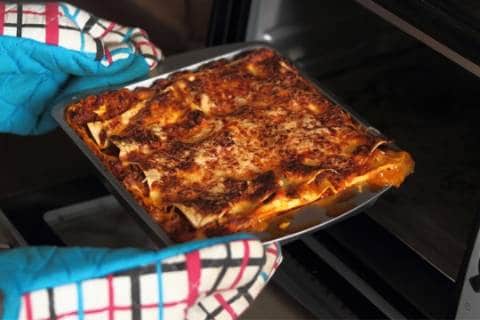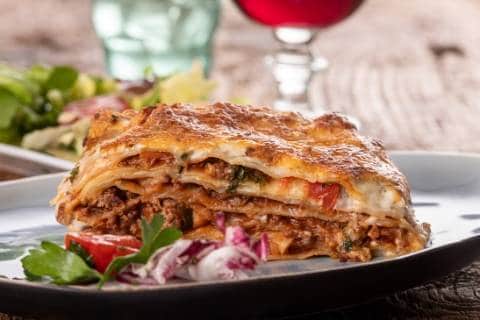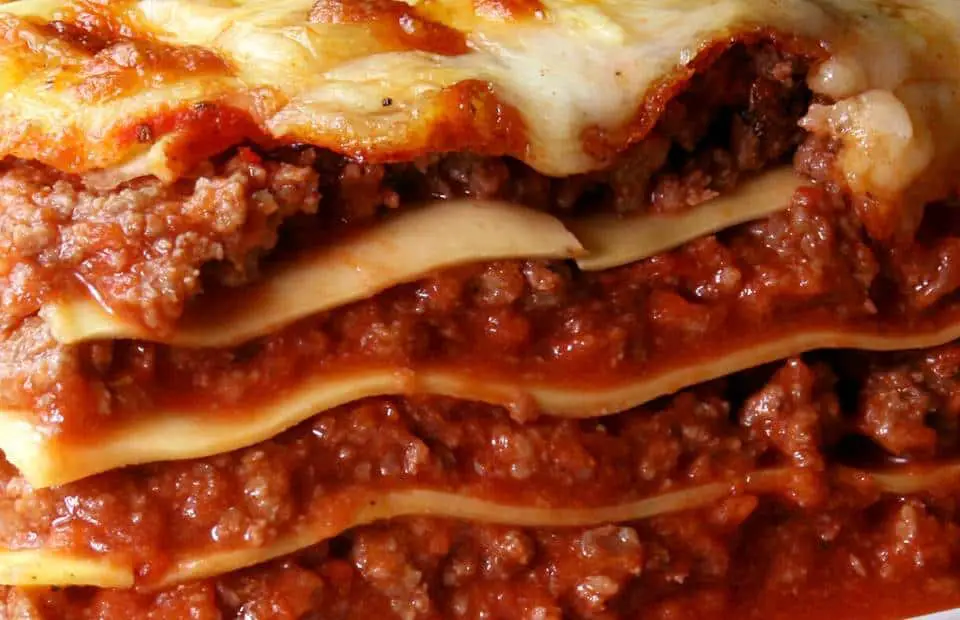This guide will explain the safest temperature and time to bake and reheat lasagna. Along with an actual recommended serving temperature.
I find it important to note that when it comes to food temperatures. Safety should always be considered first. That is why all raw meats and leftovers need to follow FDA guidelines.
I also thought something extra and fun to include in this guide, would be about optimal serving temperatures. Specifically about lasagna and how hot you should serve it.
Which when it comes to restaurants there are strict regulations that must be followed for serving food, as well as keeping it warm.
This guide is about homemade lasagna and will answer common questions about making it. With helpful charts and explanations to answer everything there is to know about cooking lasagna.
A common issue lasagna makers come across is watery or runny lasagna.
Lasagna Baking Temperature
Lasagna is typically baked between 350° and 375° F. These are the temperatures used in some of the most popular lasagna recipes online.
The good thing about lasagna. Is that there’s not an exact temperature to follow. But it also makes it sort of confusing.
Just remember that most of the ingredients do not need to be cooked once they’ve been put into a lasagna.
When making a beef lasagna for example you always cook the ground beef before. The main reason for baking lasagna is to melt the cheese, heat up the sauce and further cook the noodles.
There is a good reason for why most recipes use 350° F. Called the maillard reaction, this process is responsible for the browning of foods.
In laymen terms a reaction occurs between sugars and amino acids causing changes in color (browning). Toasting bread is a good example of the maillard reaction.
Not only does this chemical reaction change color food but it also releases unique flavors.
At this temperature food is more likely to cook without burning too quickly.
That is why 350° is so often used, even most ovens are set to a default 350°. Baking lasagna is no different.
You can bake lasagna at higher temperatures. Between 400 450° F. But this is typically done for a thicker lasagna. One made with extra layers, like a seven layer lasagna.
On the flip side you could bake a lasagna at temperatures as low as 200° F. This will increase the cooking time significantly.
This is done for one reason, to allow the flavors to meld together longer.
Why You Should Let Lasagna Rest Before Baking
Serving Temperature
What temperature should lasagna be served at? Lasagna should be served at temperatures between 150° and 160° F.
Remember that you should let lasagna rest for about 10 to 15 minutes before serving.
It’s not time. Temperature could drop 10 to 20°.
If you want your lasagna to be steaming hot. Then you should serve It at no less than 170 degrees Fahrenheit
Anything less than 140 degrees Fahrenheit would feel just warm.
I would say a serving temperature of 150 degrees Fahrenheit should be just right.
So depending on how you like your lasagna be served.
Restaurants are held to a strict standard that they must follow in serving foods. Especially buffet style restaurants. According to the FDA hot foods need to be kept and served at 140 degrees Fahrenheit.

Reheating Temperature
When you plan on reheating leftover lasagna. It is best to use either the same temperature you baked it at or slightly lower.
The reason you might go slightly lower is because there is less lasagna to heat.
Best temperatures to reheat lasagna are between 325 degrees and 350 degrees Fahrenheit.
To be safe you want the internal temperature to reach 160 degrees Fahrenheit.
Just make sure that the middle of the lasagna has become hot enough. Since it’s typically the last part to heat up.
Another good tip is to cover the lasagna with the foil for the first half of baking time.
Then remove and finish baking, this ensures that the top player doesn’t overcook.
Chef Makes The Cheapest Homemade Lasagna Possible
Baking Times For Each Temperature
Here’s a guide to the amount of time you should bake lasagna for different temperatures.
These are based on a common lasagna size using a 9×13 pan. The thicker your lasagna the longer it will need to cook.
Here is a table including the minimum baking time for each oven temperature.
| Temperature | Baking Time |
| 200°F | 34-45 mins |
| 300°F | 30-45 mins |
| 350°F | 25-35 mins |
| 400°F | 20-35 mins |
| 450°F | 20-30 mins |
Most lasagnas can be cooked for as long as one hour without any issues. This includes the total cooking time including covered and uncovered.
The simple way to do this is bake lasagna covered for half the time and then uncovered the last half.
Making a lot of lasagna at once for the holidays could mean baking two together. I figured out the best way to do this, check it out here.
Making Lasagna for a Large Group: Best Tips
Can You Cook Lasagna On Low Heat?
You can cook lasagna using low heat but if the temperature is lower than 350°, It will not brown.
Browning as mentioned earlier is due to the maillard reaction.
The Maillard reaction can occur within a few minutes as long as the temperature is hot enough.
Lasagna that has not been browned will not be nearly as good. Since the maillard reaction also imparts flavor.
Make sure your lasagna is reaching an internal temperature of 160 degrees Fahrenheit so it will be safe to eat.
You can get this reaction to occur at lower temperatures, but it would take several hours, possibly 10 or more.
Cooking lasagna at lower temperatures does have its benefits. Slow cooked lasagna can create a tastier pasta. Because the flavors have longer to meld together.
My suggestion would be to cook the lasagna at a lower temperature for about 80% of the cooking time.
Then for the last 10 or 20 minutes increase the oven’s temperature. And finish the lasagna this way, for a crispier and more brown end result.

How Long Does Lasagna Take To Cook at 200 Degrees?
Lasagna cooked at 200° F will take about 35-45 minutes. This would be for a homemade lasagna That’s immediately going to be baked.
If you are using a refrigerated lasagna, increase the time to about 45-50 minutes.
A frozen lasagna cooked at 200° should take about 50 to 60 minutes.
Again the internal temperature should reach 160° and the sauce should be bubbling.
You can cook at this temperature for much longer. Just make sure that the pasta isn’t going to dry out.
I will explain some helpful tips on how to avoid this later on in the post.
How Do You Know When Lasagna Is Ready?
You can tell lasagna is ready when the sauce is bubbling and the noodles have turned golden brown.
When we say bubbling we actually mean it’s slightly boiling. Because this doesn’t actually have to be cooked just heated enough.
Just make sure that the noodles are not pale in color.
The surest way to tell if lasagna is done would be to use a food thermometer. Check the middle and see if it is 165 plus degrees.
One sign that everything’s going good with your pasta. The smell of lasagna will start to fill your kitchen.
When you can begin to smell your lasagna, you will know that it is ready or very close.
How Long To Let Lasagna Rest Before Serving
One mistake that you can make is cutting into the lasagna too soon. Lasagna need some time after cooking to rest.
This resting allows the layers to settle and cool off. That way the lasagna is not a sloppy mess.
15 to 20 minutes is all a lasagna needs to rest and settle. This also will give it time to cool off.
Simply leave the lasagna on a kitchen counter or table uncovered.
Each slice after resting will hold a shape much better.
This one easy step of allowing the lasagna to rest, is often overlooked.
How Long Can Lasagna Sit Out After Being Cooked?

Helpful Tips and Tricks
Spray your foil with non stick oil before placing it over the lasagna. That way it doesn’t stick to the cheese.
Foil also does a good job of trapping in moisture. This can be crucial when using no boil noodles.
No boil noodles are convenient but require more moisture than if you used traditional lasagna noodles.
The moisture can come from using more sauce but aluminum foil will trap steam. Which is good for these types of noodles.
Another method is to use toothpicks sticking up out of the lasagna. They will help support the foil up.
Always add sauce into the bottom of your pan. Doing this will make sure that the first layer of noodles don’t stick and possibly burn.


Hi, doesn’t the egg(s) that you mix into the ricotta need to be cooked? That would be THE main reason for baking lasagna before I worry about melting the cheese. The egg content is the main reason to bake to at least 160 (as you recommend) and also to use an oven thermometer to ensure it reaches 160 (preferably 165). Can’t be too careful these days with eggs! 🙂